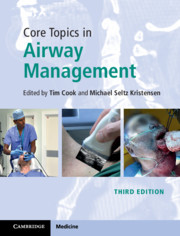Book contents
- Core Topics in Airway Management
- Core Topics in Airway Management
- Copyright page
- Contents
- Contributors
- Foreword
- Preface to the Third Edition
- Section 1 Airway Management: Background and Techniques
- Chapter 1 Anatomy
- Chapter 2 Physiology of Apnoea, Hypoxia and Airway Reflexes
- Chapter 3 The Epidemiology of Airway Management Complications
- Chapter 4 Structured Planning of Airway Management
- Chapter 5 Pre-anaesthetic Airway Assessment
- Chapter 6 Pre-anaesthetic Airway Endoscopy, Real and Virtual
- Chapter 7 Ultrasonography for Airway Management
- Chapter 8 Oxygenation: before, during and after Airway Management
- Chapter 9 Awake Tracheal Intubation
- Chapter 10 Drugs for Airway Management
- Chapter 11 How to Avoid Morbidity from Aspiration of Gastric Content to the Lungs
- Chapter 12 Face Mask Ventilation
- Chapter 13 Supraglottic Airways
- Chapter 14 Tracheal Intubation: Direct Laryngoscopy
- Chapter 15 Tracheal Tube Introducers (Bougies), Stylets and Airway Exchange Catheters
- Chapter 16 Tracheal Intubation Using the Flexible Optical Bronchoscope
- Chapter 17 Videolaryngoscopy
- Chapter 18 Expiratory Ventilation Assistance and Ventilation through Narrow Tubes
- Chapter 19 Multimodal Techniques for Airway Management
- Chapter 20 Front of Neck Airway (FONA)
- Chapter 21 Extubation
- Section 2 Airway Management: Clinical Settings and Subspecialties
- Section 3 Airway Management: Organisation
- Index
- References
Chapter 12 - Face Mask Ventilation
from Section 1 - Airway Management: Background and Techniques
Published online by Cambridge University Press: 03 October 2020
- Core Topics in Airway Management
- Core Topics in Airway Management
- Copyright page
- Contents
- Contributors
- Foreword
- Preface to the Third Edition
- Section 1 Airway Management: Background and Techniques
- Chapter 1 Anatomy
- Chapter 2 Physiology of Apnoea, Hypoxia and Airway Reflexes
- Chapter 3 The Epidemiology of Airway Management Complications
- Chapter 4 Structured Planning of Airway Management
- Chapter 5 Pre-anaesthetic Airway Assessment
- Chapter 6 Pre-anaesthetic Airway Endoscopy, Real and Virtual
- Chapter 7 Ultrasonography for Airway Management
- Chapter 8 Oxygenation: before, during and after Airway Management
- Chapter 9 Awake Tracheal Intubation
- Chapter 10 Drugs for Airway Management
- Chapter 11 How to Avoid Morbidity from Aspiration of Gastric Content to the Lungs
- Chapter 12 Face Mask Ventilation
- Chapter 13 Supraglottic Airways
- Chapter 14 Tracheal Intubation: Direct Laryngoscopy
- Chapter 15 Tracheal Tube Introducers (Bougies), Stylets and Airway Exchange Catheters
- Chapter 16 Tracheal Intubation Using the Flexible Optical Bronchoscope
- Chapter 17 Videolaryngoscopy
- Chapter 18 Expiratory Ventilation Assistance and Ventilation through Narrow Tubes
- Chapter 19 Multimodal Techniques for Airway Management
- Chapter 20 Front of Neck Airway (FONA)
- Chapter 21 Extubation
- Section 2 Airway Management: Clinical Settings and Subspecialties
- Section 3 Airway Management: Organisation
- Index
- References
Summary
Face mask ventilation is a basic skill taught to and practised by a large array of medical practitioners. It is usually the first technique applied to an unconscious patient or victim that is unable to generate effective oxygenation and ventilation. Although it is considered a simple technique its outcome is often suboptimal. This chapter describes face mask ventilation devices, techniques and the concept of difficult face mask ventilation. The one- and two-hand face mask ventilation are reviewed in the context of the airway manoeuvres used to address the upper airway obstruction of the supine unconscious patient: head extension, jaw thrust and the triple airway manoeuvre. The concept of measuring the adequacy of face mask ventilation using known objective ventilation outcome markers (tidal volume, airway pressure and the capnogram) is introduced to contrast with the routine unreliable subjective markers (cyclical condensation of the mask dome and bag compliance). Reassessment of face mask ventilation technique using objective ventilation markers is encouraged to further optimisation of the outcome. The predictors and the management of face mask difficulty is examined from a practical point of view.
Keywords
- Type
- Chapter
- Information
- Core Topics in Airway Management , pp. 97 - 101Publisher: Cambridge University PressPrint publication year: 2020



